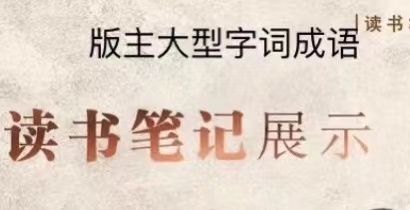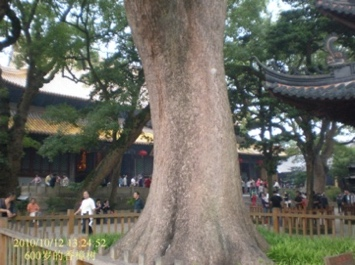As a child, I dreamed of travelling, which came true after I retired. There is time and fund, which is not enough; there must be internal power, or you will lose the interest and even think of it as an activity to spend money seeking torture, without any sense. Like reading thousands of books, travelling can also add to one’s knowledge and trigger your thinking. There is doggerel, saying “Once getting on the bus, fall asleep at once. Getting off the bus, only see temples. What had been seen? Nothing else.” I concentrate diligently on my learning and should also have a smart experience. If I were always plunged into a bitter and hard state, I would always have lived in autumn without spring, no animation. I should enjoy travelling to all the places I like. According to the geographical location of the beauty spots, we choose an appropriate season to go to the famous mountains and rivers, demonstrating the life enthusiasm, highlighting the life vitality, and why not going ahead with it. The verses by Li Bai: Honors and riches floating clouds; wonders of natural beauty boundless.
In the first five years after the retirement, we spend two years in Australia, living together with the family of my first son, looking after our grandson, and enjoying the different sight of another country in the southern hemisphere. The other three years noticed me not only studying and writing but also saw us travelling to the far scenic spots of our own large country. In August of 2007 we went along the silk road and reached the foot of Tianshan Mountain; In September of 2007 we flew to Thailand, seeing the performance of shemales and the Emperor Palace in Bangkok; In January of 2008, we had a touch with several people of minorities in Yunnan Province, acquainting ourselves with their local customs and practices; In March of 2008 we paid a visit to one of the eight wonders in the world, Terra-cotta Figures in Xi’an; In May of 2009, we climbed the Huangshan, whose scenery looks like pictures; In September of 2009, we toured most famous scenic spots of Sichuan Province, including Jiuzhaigou, Huanglong, Giant Buddha in Leshan City, Emei Mountain, Three Grand and Small Gorges and the Three Gorges Dam Project.
On 27, August, 2007, we took a special travel train and left Xuzhou. In order to treat ourselves well, we had ordered two soft sleepers. The first stop was the famous Dunhuang in Gansu Province. The train passing by Jiayuguan Pass, it stopped at a station named Liuyuan. We entered the travel omnibus and moved on No. 215 National Road (G215) southwest forward, getting to the county city Dunhuang. On the both sides of G215, there were still Gebi Deserts. Drawing near Dunhuang, we saw some higher camel thorns, a kind of plant in the desert, perhaps kind of cactus, which can be eaten only by camels. However, when we were inside the city we saw green trees giving large shadows and flowers and grasses like those in the cities near the sea, rich green and in blossom. Especially when we got to Mogao Caves, a lot of tall and straight Xinjiang poplars came into our sight, no mark of the desert, which was in fact very close and you could get to on foot in a moment, where we put on boots, and rode on a camel, going around a sand hill, causing my buttock and waist to be very much tired and in pain, typically spending money seeking torture. What surprised me most was Yueyaquan, the crescent spring water, which was surrounded by the desert sands, 150 meters long and 50 meters wide, like a crescent moon. The water in it was clear and transparent and had never dried up. A song text about it says, “It is the mirror of the sky, and the eyes of the desert”. I had no interest in frescos and stories about Sutta Pitaka in Mogao Caves, but felt puzzled at the short distance between the oasis and the desert, just like that of one’s advantages and disadvantages.
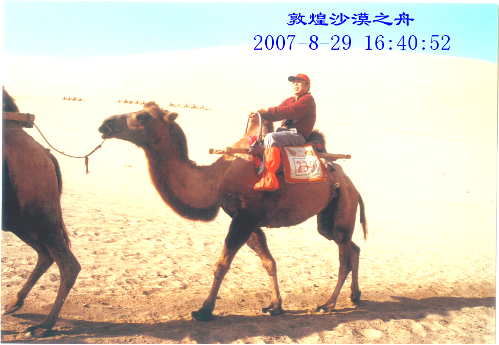
Ride on a Camel in Dunhuang
The second station our train stopped at was Turpan of Xinjiang. The song “the grapes of Turpan is ripe” is sung all over China and made Turpan famous in the whole country. Turpan Railway Station is almost 50 km from the city and the grape ditch is 15 km from the city, where the trees luxuriant, air moist, the climate cool and pleasant, which formed the bright contrast to the blazing flame mountain. The guide arranged for us to pay a visit to a Uygur family. The master was busy watering his grapery. We sat in the court, degusting the fresh grapes and honey-dew melon. When we were about to leave, we bought some dried grapes to thank the master. The legendary flame mountain lies 10 km to the northeast of Turpan, where the red sand seems to burn and not any plant can grow.
Where does the water in the grape ditches come from? The water comes from the melting snow on the top of Tianshan Mountain by the karez system, which is claimed as one of the three greatest water projects of China, linking it with the Dujiangyan Irrigation System and the Grand Canal. The word karez means “well” in the local Uyghur language. Turpan's well system was crucial in Turpan's development as an important oasis stopover on the ancient Silk Road skirting the barren and hostile Taklamakan Desert.
The tour omnibus carried us from Turpan to Urumqi on G312 and G182 (National Road). Tianshan mountain Tianchi national key scenic area is located in the Xinjiang Uygur autonomous region within the territory of Fukang, from Urumqi 110 kilometers, altitude 1980 meters’ altitude. In Tianchi you can see snow-capped mountains, forests, clear water, lawns, and blossom scenery. The lake is clear, glittering and translucent like jade.
When you travel to Xinjiang, you are sure to pass through the Gobi Desert. We entered it in the afternoon and when we woke up in the next morning, the train was running still on the Gobi Desert, which measures over 1,610 km from northeast to southwest and 800 km from north to south, where there were no living things on the land, bare rock everywhere. Once the huge wind blew, yellow sands were flying like a heavy fog, covering the sky and the sun. The whole region was populated with nobody, in complete desolation. It is said that because of dry weather, relatively loose rocks were air slaking and being denuded, becoming chipping material, among which fine sands and dust were blown to the sky and moved far away, forming Loess Plateau. Fine sands were blown not far away, forming the desert. Because of the long diameter of the gravels, they stayed, forming today’s Gobi Desert. Every inch of the territory is precious and the stifling Gobi Desert is the same. It is said to be rich with petroleum and natural gas. Every now and then we saw the oil pump working in the distance. People go to the south and north pole, go to the moon and I believe that the Gobi Desert is much better and much more suitable to live and work. Nowadays there are not only trains on it, but the national roads are running in all the directions, forming a high-speed highway web. The Gobi Desert is going to develop and will take on a new look.
It was not long before we flew to Thailand. On the 19th, September of 2007, we took a plane from Pudong Airport, Shanghai, to Thailand, with the pair of Youci Zhang and Yanrong Ma, our good friends. With us were other members of the team who invested into the website run by SUCCESS RESOURCES GLOBAL LTD of Singapore. From 2005 to 2007, the price of the stocks of all stock exchanges in the world was skyrocketing. On the fifth, August, 2005, Baidu Netcom Science and Technology Co went to the NASDAQ, with each share, 27 UD. The opening price was $66, and then rising immediately and continuously and the close quotation got to $122.54. Four hundred employers of Baidu became coin money, cakes with stuffing falling from the sky, like an old Chinese fairy tale. We were also drawn into the website run by SUCCESS RESOURCES GLOBAL LTD of Singapore, investing enough to travel to Thailand and dreaming of making fortune by buying and selling stocks. No matter what happened, travelling in Thailand was part of my plan to travel thousands of li.
An assembly was held in Pattaya, a small city by the sea, which was 154 km southeast from Bangkok, the capital of Thailand. It has beautiful scenery and comfortable weather and is a famous newly-built holiday-inn. The reception work was pleasing and the diet was similar to that of China. After all, it is a close neighbor to our country. We saw famous shemale’s performance. What is called the shemale was those who were men and looked like beautiful women. They were like actresses, singing and dancing. They are not similar to those actors in China, who are dressed up like actresses. The shemale took in the female sex hormone and grew into a metamorphic girl. There were two shemale arts groups in Pattaya and we saw one performing in an evening.
Another grand scenic spot is Thailand Emperor’s Palace, which was built in 1782 and has the area of 218,000 m2 (while the Palace Museum or Imperial Palace in Beijing 720,000 m2). It was the best-reserved, largest-scale and of the national characteristics emperor’s palace, which was called the palace museum of Thailand. The spires of the stupas seemed to touch the cloud and the scale glass tiles were shining in the sun. Entering the inside, you could see the yellow color everywhere and on everything. Buddhism buildings were sparkling in the sun, showing their dignity and nobleness. The whole architectural complex was beset with large quantities of shining jewelries, colorful glasses and gold foils. Being bright and limpid, beautiful jades flashed the oriental color. All that entered the palace were in yellow T-shirt and it made the still and moving views look all yellow. All of us were impressed deeply.
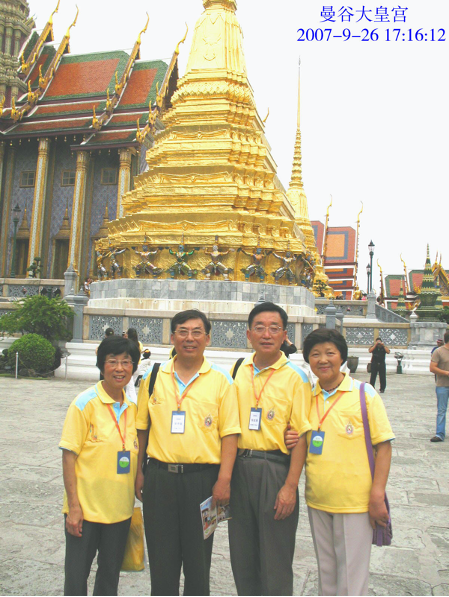
Thailand Emperor’s Palace
Yunnan was the place I had been dreaming of travelling to. The main purpose was to watch the minorities fond of singing and dancing. As a child, I saw the film “Five Golden Flowers”, “Ashima” and began to have interest in the beautiful place where the fascinating story happened. It became convenient to go there because there was air-flight from Guanyin Airport of Xuzhou flying directly to Kunming. At the end of 2007, ¥7000 royalties came to my account, and on 12, January of 2008 both of us flew to the place we had been dreaming of for decades.
The four seasons of Kunming are all like the spring and the journey has no off-season. We first went to The Stone Forest lying about 78 kilometers to the southeast of Kunming. A geological phenomenon, the Stone Forest was a vast expanse of sea during the Paleozoic era--some 270 million years ago. Later, the movement of tectonic plates altered the earth's crust, causing the sea to recede and its limestone bottom to appear, thereby forming land. Due to the constant seeping of rain through the cracks in the limestone, some of the stone formation dissolved and the fissures broadened, producing a group of great sculptures of different shapes, all molded by nature.
Coming back to Kunming we took a train to Dali ancient city, where Bai ethnic minority folk lived and the story of “Five Golden Flowers” took place, which represented five beautiful Bai girls. We got to the butterfly spring, watching the Bai girls singing and dancing. We rode in a tour bus from Dali to Lijiang ancient town, in which the roads were parallel to the streams, and the door of each house was facing a stream. Whatever street and whatever lane you went into, you could see a small stream with small bridges across it here and there.We were led to a family of Naxi minority. The young house wife marketed tea to us and introduced us the tradition of her folk. Naxi folk performed the tradition of the man coming to the woman and marrying. The men enjoyed playing the musical instrument and chess, reading books, drawing pictures, smoking and drinking tea, just like a lady in Han region, living upstairs. When we got to Xishuangbanna and paid a visit to a girl of Dai Minority, who told us that Dai people kept the female line. The boy was said to be goods which could not earn but lose money instead. The Dai girl receiving us found a boy, who now worked in her home and it would last three years before she decided whether to marry him or not. Her brother went to another home, working to see whether the girl of the family would accept him or not.
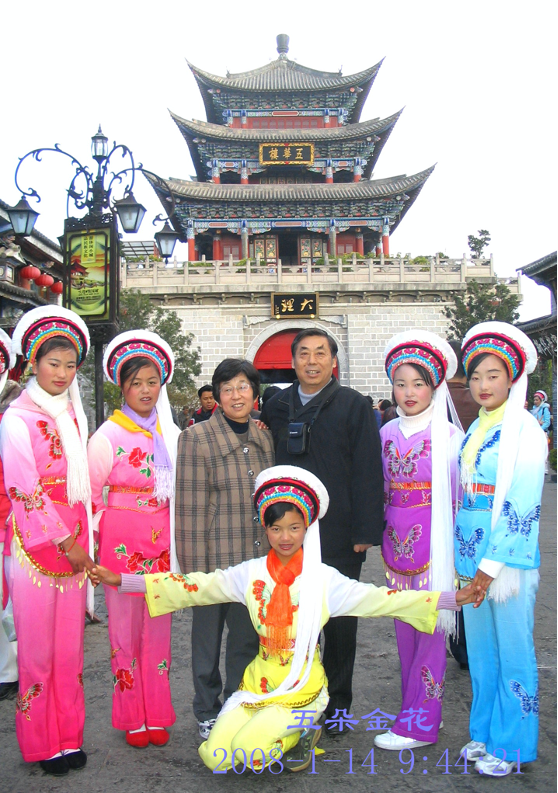
Five golden flowers in Dali
The flights between Kunming and Xishuangbanna were like buses going and coming, every 15 minutes a plane taking off. We stood in a line, waiting for the flight and did not catch the flight we hoped. However, when we arrived at the Xishuangbanna Airport, the people who took the earlier flight were waiting for us in the bus.
Arriving at Banna, you should be sure to pay a visit to the wide virgin forest. In Australia we had seen the gum virgin forest, causing us to be excited and convulsed. We admired the natural resources the nature had given to human beings. China had also a lot of virgin forests. The Banna’s one is pleasing for you to see. It was so large that we walked inside for more than two hours and covered only one corner of an ice mountain. It had a lot of varieties of trees: broad leaved forest, coniferous forest, bamboo forest, shrubbery and etc. Great and tall trees could be seen everywhere and you could also see the strange scenery of the ancient bines climbing up the tall arbor and a bine web woven between trees. The cable car moving over the Wild Elephant Valley was the longest route we had ever ridden. Seen from the above, the beauty of the nature appeared more natural, making us relaxed and happy. We were not lucky enough to see wild elephants, but we saw the elephants’ performance, humorous and pleasant.
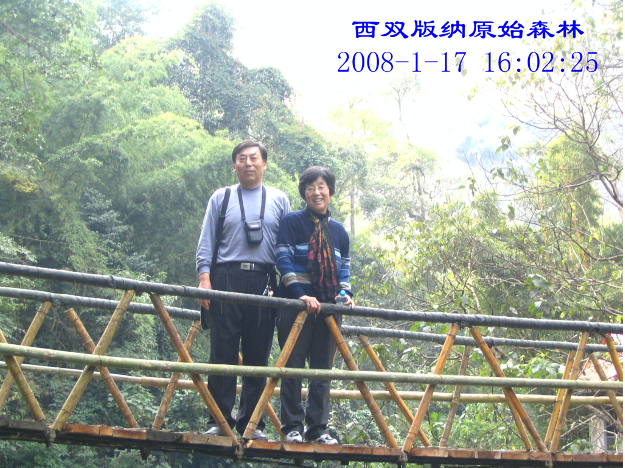
Virgin Forests in Banna
It was worthy of giving an account that when we got to Kunming Airport we were noticed that Xuzhou Guanyin Airport was covered with snow and the plane was not allowed to land. We had to come back to the hotel and stayed for another day to listen to the information. In the city of Kunming, it was warm like a spring. We took advantage of the day, entering the Expo Park with flowers everywhere, which presented a striking contrast to the weather of Xuzhou. It was kind of lucky for us that the plane took off the next day at 5 pm of Jan. 20 and arrived at Guanyin Airport at nine plus pm. The whole airport was covered with thick white snow except for the runway. We dare not go out until we put on cotton quilted jacket and woolen trousers.
On the second of March, 2008, Liangliang Song and Lei Meng came to us from Chicago of the US and then they went to Xi’an, to Lei’s parents, who invited us to Xi’an for a visit. In 1966 when the Cultural Revolution broke out I had been there. It was 42 years ago and great changes had taken place in Xi’an. On 18 of March we took a train and the next morning we got there. Lei’s patents accompanied us, sightseeing. We came to the Xi’an Museum, BIG and Small Wild Goose Pagoda, and on the last day we paid a visit to one of the eight wonders in the world, Terracotta Warriors.
Museum of Emperor Qinshihuang’s Tomb Figures of Soldiers and Horses is located at the foot of Lishan of Lintong District, 37 km from Xi’an. The remarkable sight appeared in 1974. Some farmers happened to dig up what turned out to be a large-scale pit with terracotta soldiers and horses, belonging to the Emperor Qin Shi Huang, or the Founding Emperor of the Qin. The figures that the farmers found were around the size of real people. After 2,200 years, the Emperor's tremendous army stood as though living again before people's eyes. After further excavation they actually found that the area of the discovery was a great deal larger and that inside this area were buried some 6,000 terracotta figures of horses and soldiers. After this, archaeologists discovered a second and third pit of horses and soldiers: the first discovery was called #1 pit, nearby in test excavations they discovered pits #2 and #3. Linked together, the three pits covered an area of 20,000 square meters and included around 8,000 figures.
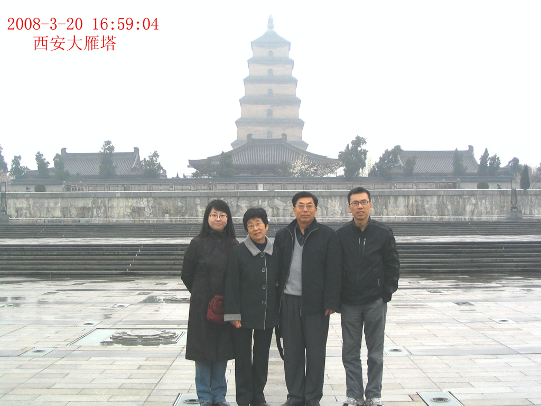 | 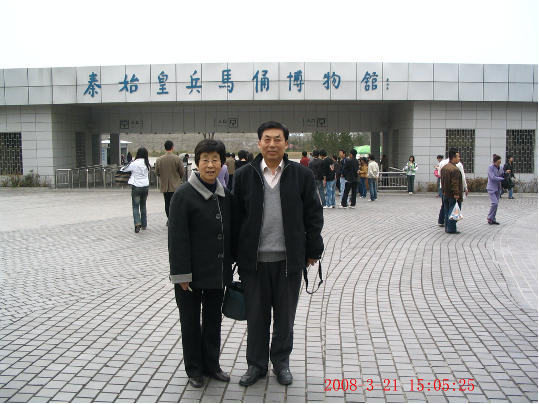 |
Big Wild Goose Pagoda Museum of Emperor Qinshihuang’s Tomb Figures of Soldiers and Horses
Yellow Mountain (Mt. Huangshan) was a spot I had been dreaming of getting to, because of all the notable mountains in China, it is probably the most famous. It is said that you won't want to visit any other mountains after seeing Wu Yues (five famous mountains) but you won't wish to see even Wu Yues after returning from Yellow Mountain. (Wu Yues namely Mt. Taishan in Shandong Province, Mt. Huashan in Shaanxi Province, Mt. Hengshan in Shanxi Province, Mt. Songshan in Henan Province and Mt. Hengshan in Hunan Province) Yellow Mountain owns the advantages of famous mountains in China, which looks as majestic as Mt. Taishan, as rugged and steep as Mt. Huashan. It owns beautiful cloud as Mt. Hengshan in Hunan Province, and falls as Mt Lu in Jiangxi Provicne, artful stones as Mt Yandang in Zhejiang Province and beauty as Mt Emei in Sichuan Province. Before starting off, I was afraid of my ability. After all I got old and esp. my right leg was injured. I was concerned about whether I could get to its top. I was determined to turn my dream into reality. On 7th of May, 2009, we three, including Meilan’s brother, Xinshun Zhang, took a tour bus directly toward Huangshan. Within the scenic region, we were transferred to an electric car, beneficial to the environment. Then we got to a cable car holding more than 40 people, just like a huge bus, climbing up to the half way, each seat ¥80. I thought it was good enough for me to reach the top. Beyond my thought, it still had a very long way and there would be a lot of difficult steps for me to climb. The distance between the cable car station and the Huangshan Guest Pine tree made me out of breath. There were much longer steps waiting for me. I held a cane, one step after another. Tired, I stayed for a while and then continue to go forward. In the end I followed both of them and stood at the Guangming Peak, with altitude 1860 metres. “Unlimited scenery in the perilous peaks”, when we were at the top we could enjoy its whole beauty. That day, the weather did not help, always smoke and fog covering the mountain, as if it would rain. However, when we were about to the top, the sun smiled from the cloud, making us joyful. When we saw downward, crowd of tourists climbing toward three main peaks came into our sight, making you thinking of the attraction power of Huangshan to the tourists. Large high and relatively small peaks extending in all directions, forming deep and dark valleys and steep walls, towering, sheer, and elegant, properly located and natured. I mentioned in the earlier memory the strong life force of the pine trees on Mt. Huangshan. Now I was on it and experienced myself the spectacular scenery of “no peak without stone, no stone without pine and no pine without producing wonder.” Actually, the pines growing on the rimrocks and sheer cliffs have much longer roots, ten even scores of times, than their own trunks and branches, which make the pines evergreen with nutrition coming up. They stand high on the apex and astonish everyone present.
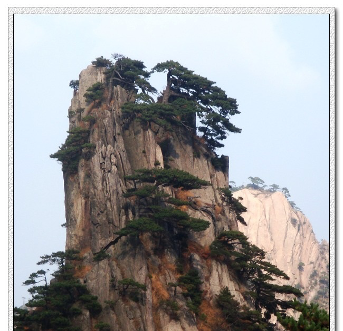
Pines standing high on the apex
In September of 2009, we decided to travel to Sichuan, going along the Yangtze River to Three Gorges Dam Project. 5 pm of the third of September we rode in a train to Chengdu, which took us 26 hours. In the early morning of Sept. 4 we started off for Jiuzhaigou's entrance gate. Because the earthquake took place a year plus ago, the road still had the landslide trail, where a lot of construction workers were busy repairing. Winding highway on the mountain, one layer after another, appeared very frightening. Especially when the bus was turning the corner, I was so terrified that the skin of my testicle was shrinking, which could be described as heartquake. The mountains on both sides of Min River had no plants at all, with bare stones and rocks supporting each other. The balance seemed to be temporary and a bit of exterior force might drive them falling down quickly. The highway could not be widened and only on some points was the road made kind of wide so that the vehicles could pass, face to face.
Jiuzhaigou literally means nine Tibetan village gullies and now the basic construction is complete. You buy one ticket and the electric bus can carry you to reach every scenic spot, being free to get on and get off. Its beauty lies mainly in water because there are large number of lake groups and waterfalls. The trees and grasses being thick on the mountains and the slopes, the water flowing down is clean and clear. You can see the bottom of each colorful lake. In addition, the water is flowing continuously, reminding us of the proverb “The running water is not spoiled.” We were encouraged enough to use the bottle to hold some water for thirst, cool to your heart, absolutely clean. The natural mountains, water, trees and grasses are my favorite, which are not polluted a bit. In addition, the basic establishment is pleasing and you don’t need to climb or go a long way, accordingly, Jiuzhaigou is an ideal place for the senior to wander.
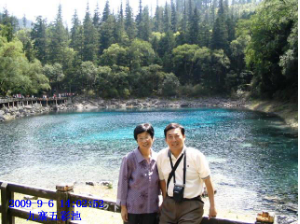
Scenery of Jiuzhaigou
The second day, ie. on the sixth of Sept. we got to Huanglong, whose altitude is more than 3000 metres, similar to that of Lasha. It is said that if you have no altitude stress here you could go to Tibet. The guide marketed capsules of safflower preventing you from altitude stress by frightening and fooling you. The guide said that it could be effective immediately and so everyone bought including us. Large amount of money entered the bags of the guide and the seller. When we were back at home and looked up, discovering that you must take such capsules two or three days ahead. Cheating need not talk with you. Almost all the tourists who visited Jiuzhaigou with us came to Huanglong and I did not found any of them had altitude stress. We first took a cable car, almost straight upward, along the steep slope and then began to go on foot. It was a very long way for us to go before we got to the top. We saw small yellow lakes one after another on terraces, as if yellow paint was saturated, fresh and creamy. It was said that they were sediment of calcium carbonate. So many yellow lakes were terraced like a golden dragon, so it was called “Huanglong” (Yellow dragon) In the scenic region there were new-built wooden walkways. All the wood sticks were carried by the villagers, just like Mt. Tai carriers. We saw them going up step by step with heavy sticks on their backs, too hard job for us to do.
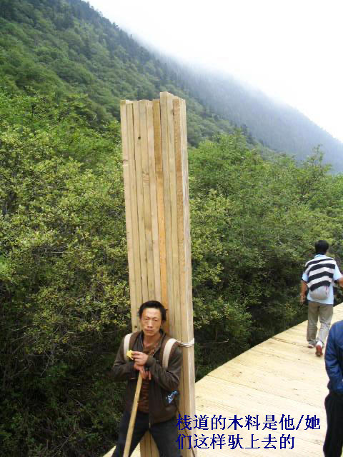
All the Wood Sticks Carried by the Villagers
When you arrived in Sichuan, you must go to Mt. Emei, which is one of the four most famous Buddha Mountains. The top has the altitude of 3099 meters, many peaks with cliffy walls, ravine deep and quiet, falling fall like curtain, cloud sea rolling and surging, forests green and verdant. It was what is called “Emei is the most beautiful of the country.” Along the mountain road there appeared clouds of monkeys, gathering to ask for food from the tourists, which was a pleasing characteristic. Before we went long, we did see a cloud of wild monkeys. I am a fan of monkeys. Once I see one I stay and have a long-time careful watch. I like its every act, namely scratching itself, catching lice, breaking melon seeds, drinking the soda and etc. When I got to Wannian Temple, one of the eight major temples on Mt. Emei, I didn’t enter it because there were wild monkeys in front of it. I sat down, taking a rest and having a good watch on their activities. Monkeys broke peanuts quicker than we did and it took a small monkey a few minutes to break a pack of peanuts and ate all of them. I was afraid that it would make its stomach too full. An old hand beside me said that in monkey’s oral cavity there were two cheek pouches, which could be used to store foods for the future use. When the monkey could not find food, it could use the food in them. You must be careful when playing with monkeys. A beautiful girl was approaching an old male monkey and handed a cookie to it. The monkey suddenly attacked her by jumping to her body and her boy friend frightened the monkey with a stick and comforted his girl friend for a long time.
When the bus went to Mt. Emei, it passed by Leshan, where the Giant Buddha was located at the confluence of the Min, Dadu and Qingyi rivers. It qualifies as the largest Buddha in a sitting posture in the world, 71 meters high. Tourists could climb down to its feet and then climb up to its head, equal to climbing a 100-metre hill, making you exhausted. In the picture or the video, you could not experience its height. Only by climbing could you know how high it is. When you climb down, it is a kind of easy and when you climb up, it would be no easy job. I used a cane, one step by another. Tired as I got, I was willing to do so and had such a feeling that I didn’t come in vain.
Du Fu (712~770) Thatched Cottage was inside the city of Chengdu and you are free to enter it. I am not familiar with the ancient Chinese poems and sometimes enjoy reading or citing some of them. Paying a visit to it might encourage me to review some famous works of Dufu and enrich my knowledge of ancient poems. In 759 he arrived in Chengdu. He set up a modest cottage with some money he borrowed from his friend who served as a local governor. In the cottage he had a simple and peaceful life for three years, writing about 2400 poems. These poems convey the impression that he was happier in Chengdu than any other time in his life. The poems of this period sound relaxed and happy. The most famous is “A good rain knows its season”, which a lot of Chinese children can read orally.
A good rain knows its season
It brings thins to life right in spring
It enters the night, unseen with the breeze
It moistens things gently and without sound.
Some of Du Fu’s poems entered my electronic notebook. I wish that one day I could study their prosody and enter the ancient Chinese poem hall.
It was already in the first ten days of September, but however the city of Chongqing was still a hot stove. To avoid being roasted we decided directly to go to Wanzhou Wharf to cruise the Yangtze River, enjoying the beautiful landscape of the Three Gorges until the Dam Project. We spent three nights on board. When arriving at a scenic spot, we got off and then began a shore excursion. For example, we saw Zhang Fei Temple at a night. The Three Gorges starts at Baidi Town of Fengjie belonging to Chongqing City and ends at Nanjinguan Pass of Yichang City in Hubei Province. As a young student, I got touch with the poem written by the romantic poet Li Bai of the Tang Dynasty “Sailing at dawn from Baidi Town”
We set sail at dawn from Baidi Town under a rosy sky,
A thousand-li trip down to Jiangling took only one day.
The noisy chatter of apes from both shores could not stop us streaming down.
Lightly, our boat skipped past ten thousand cliff mountains.
Now I myself was at Baidi Town, helping me understand the artistic conception of the poem much better. It was about 1200 li from Baidi Town to Jiangling (now Jingzhou City, Hubei Province) and between Three Gorges is 700 li long. The high altitude of Baidi Town made the boat stream so quick that the whole journey of 1200 li took only one day, just like a quick train of modern time, starting off at dawn and arriving at sunset. The poet integrated spectacularity and varieties of appearances of the landscape with mellifluence and springiness of the downstream boat, which could be better understood if you could experience it yourself. The Three Gorges are Qutang, Wuxia and Xiling, which are famous for their majesty, sinisterness, oddness and serene. When the Yangtze River reaches the eastern Sichuan Basin in southwest China, it cuts through the Wushan Mountain. Here the river course suddenly narrows and the waters become turbulent. Sheer cliffs and steep mountains rise on either side, creating one of nature's most fantastic sights. The Gorges vary from 300 meters at their widest to less than 100 meters at their narrowest.
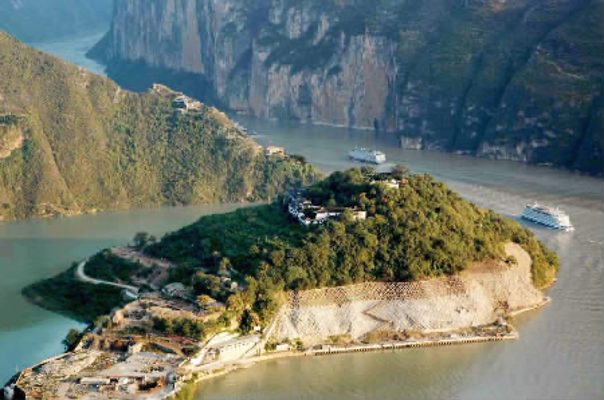
Three Gorges Dam hoisting the water level and Baidi Town becoming an island
Qutang Gorge is the smallest and shortest Gorge, 8 kilometers, but grandest of the three. The Yangtze River, mighty and rapid here is suddenly contained like "a thousand seas poured into one cup", as the Song Dynasty poet Su Tungpo described the spectacle. Marshal Chen Yi wrote a poem named “passing Three Gorges once more”, in which there were such a sentence “passing through thousands of dangerous beaches, water head like an arrow broke Kuimen Gate.”
Wu Gorge extends 40 kilometers, especially deep, silent and winding. The whole gorge is full of high peaks, bizarre stones and barrancas like screens, extending one after another and is the most fantastic section of the Three Gorges, just like a winding gallery, full of poetics and literature.
Xiling Gorge which stretches 78 kilometers eastward and the cliffs on either side rise to just over 900 meters. The big gorge contains a lesser gorge. We landed and took a boat excursion up Daning River to the Lesser Gorge and up Madu River to the Least Gorge. On both sides stood also steep cliffs and the watercourse was so narrow that only boat could sail on it. Being here could help you understand what “Romance of Three Kingdoms” described, “Yangtze collects water from hundreds of rivers, flowing into East Sea; Yangtze experiences billions of years, raising waves forever.”
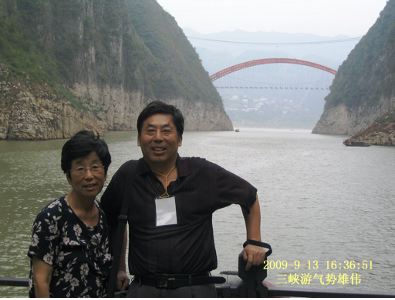
Tour in Three Gorges
The Yangtze Gorges are changing since the well-known Three Gorges Dam Project began to be built in 1994. The dam is 185 meters in height. The installed power generation capacity is expected to be 18.2 million kilo watts. With the dam built, the flood in the Yangtze River valley will be controlled, navigation improved besides the economic benefits. The Large Reservoir is more than 600 km long. When we got there, it was filled with fog and we could not see it clearly. No sluice was open and the giant dam was lying there silent. We only see the swirls of water at the east side of the dam, indicating that the hydraulic power generators were working hard.
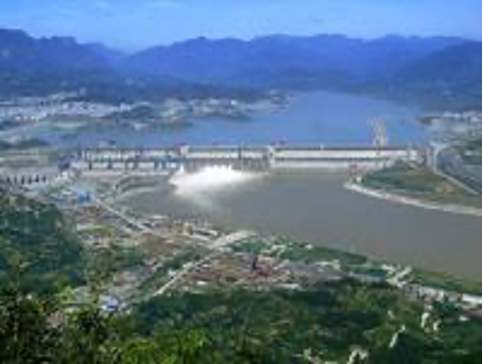
Three Gorges hydraulic power station
Travelling in Sichuan was somewhat self-service. We bought train tickets ourselves, got contact with the travel agency online, and altered the route amid the course. Because of the long journey, plus three-night stay in the cruise, it took us altogether 12 days and half and the whole expense was¥5400.
One of my major things after the retirement is reading. During the period of my childhood I had no condition to read. I had no idea what to read and finished reading only some popular novels. When I began my teaching career, I was busy and had no time to read besides reading the professional classics. Retired, I have a lot of time and formed the habit of reading every day as long as I had to do something more important. There are varieties of e-books online and you can use books freely. I like to write the electronic notebook, which is quick and convenient for me to copy, search and edit. I am much more patient than before and read famous essays, articles and books both in English and Chinese. First I got touch with the famous ancient Chinese books written by the thinkers during the spring-autumn period and warring states, including those by Confucius. I also read some Buddha articles, Zen Buddhism. I have a plan to reread the famous works, such as “Romantic of Three Kingdoms”, “A Dream of Red Mansions/Chamber”, “three ladies of easy virtue, Jin, Ping and Mei”. Mr. You Mao of Song Dynasty said, “When you are hungry, books can be used as meat. When you feel cold, books can act as habiliment. Lonely, you can make friends with script and worried books can sound music as instrument.” What Mr. Qiuyu Yu said sounds reasonable, “What most important of reading is to get rid of commonplace. Reading one day earlier, you can add a wonder to your life; one day later, you would be harassed one day longer by commonplace.” In addition to what is said by the famous above, the main purpose of my reading is to improve my words and expressions. Therefore, I am sure to look up the e-dictionary when I meet upon a word or an expression I don’t understand and write them down in my e-notebook. By reading, and writing them repeatedly I try my best to remember them. Instead of reading without understanding, I read them very carefully, as intensive materials. Reading is for writing. “Reading thousands of books, travelling thousands of li and writing hundreds of thousands of words is my main activity after the retirement. “Reading” and “travelling” is the base of “writing”, without the former two, writing will become water without source, or a tree without roots. The e-notebook is very useful. I can judge whether a word or expression is in it or not by searching it. As long as I have some impression of some words or expression I can search for it and can use it in my writing immediately. A writing expert in my province said, “language is the ‘iron doorsill’ that there is no shortcut to. The only route to it is to accumulate your words and expressions absorbed from written literature works, which are not used orally at your pleasure. The experience I have gained from the writing for years is that you can change the excellent words and expression into your own only by your own writing. Usually you have to use a beautiful word or expression 3 to 5 times, then it could become your own.” The truth lies in the fact that you have to work hard and get away with the peacockery. The main purpose of my reading English is to edit something to be published and therefore I read only passages rather books. Before I begin to edit, I have to read them again and again, in case my mistiness tries to make the reader understand. Reading Chinese articles and books, writing essays in Chinese and writing my memoir are not profitable. Reading English and editing teaching courses can get some profit for our travelling to all the places we like.
Dec. 10 of 2011 in Chicago
Proofreading on April 30 of 2012 in Xuzhou
Second proofreading on Jan 2 2019 in Fenghuayuan Xuzhou
Uploading on Aug. 8 of 2023 in Xuzhou



